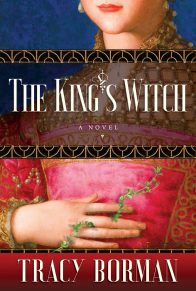Much of the fascination with Britain’s legendary Tudors centers around the dramas surrounding Henry VIII and his six wives and Elizabeth I’s rumored liaisons. Yet the most fascinating relationship in that historic era may well be that between the mother and daughter who, individually and collectively, changed the course of British history.
The future Queen Elizabeth was not yet three when her mother, Anne Boleyn, was beheaded on May 19, 1536, on Henry’s order, incensed that she had not given him a son and tired of her contentious nature. Elizabeth had been raised away from court, rarely even seeing Anne; and after her death, Henry tried in every way to erase Anne’s presence and memory. At that moment in history, few could have predicted that mother and daughter would each leave enduring, and interlocked, legacies. Yet as Tracy Borman reveals in this first-ever joint portrait, both women broke the mold for British queens and for women in general at the time. Anne was instrumental in reforming and reshaping forever Britain’s religious traditions, and her years of wielding power over a male-dominated court provided an inspiring role model for Elizabeth’s glittering and unprecedented 45-year reign. Indeed, Borman shows how much Elizabeth—most visibly by refusing to ever marry, but in many other more subtle ways that defined her court—was influenced by her mother’s legacy.
In its originality, Anne Boleyn & Elizabeth I sheds new light on two of history’s most famous women—the private desires, hopes, and fears that lay behind their dazzling public personas, and the surprising influence each had on the other during and after their lifetimes. In the process, Tracy Borman reframes our understanding of the entire Tudor era.
Praise for Anne Boleyn & Elizabeth I:
Named a Top 10 History Book of the Year by Smithsonian
Named a Best History Book of the Year by Waterstones
“A deep and compelling dive into the lives of this extraordinary mother and daughter . . . Borman, who is an amazing writer, delivers a captivating and exquisitely heart-wrenching account of the mother and daughter duo who radically changed English history forever . . . Thought-provoking and moving in its account, Borman skillfully details how Anne Boleyn’s family, intellect, and tragedy ultimately shaped Elizabeth I’s extraordinary reign. A must-read for any student of history and especially Tudor fans.”—New York Journal of Books
“Masterfully corrects the historical record . . . It’s in the details Borman shares illustrating the mother-daughter relationship that this book truly shines.”—Washington Independent Review of Books
“A seminal and groundbreaking work of meticulous, extraordinary, and detailed scholarship.”—Midwest Book Review
“Historian Tracy Borman triumphantly shows that Anne Boleyn’s love and influence guided her daughter, Queen Elizabeth I, through her tumultuous life and much glorified reign . . . Citing evidence from correspondence, material objects and the observations of witnesses during Anne’s brief reign as queen and Elizabeth’s long one, Borman recreates the relationship between the two women as loving and full of significance, even after Anne’s death . . . Anne Boleyn & Elizabeth I offers a fresh perspective on Tudor history. Set against the many volumes about Henry VIII’s rule and Elizabeth I’s influence, Borman’s book triumphantly pulls the fiery, educated Anne from the shadows and restores her to her rightful place as a reformer, patron and queenmaker.”—BookPage (starred review)
“Rewarding . . . Beautifully envisioned and full of insight, this is a must-read for Tudor history buffs.”—Publishers Weekly (starred review)
“A fascinating corrective to the historical limbo into which this crucial connection had fallen . . . Through [Borman’s] painstaking research for Anne Boleyn & Elizabeth I, even the most trivial scraps of information about Anne’s life and activities take on vivid importance, becoming pieces of a human mosaic that reveals just how similar mother and daughter were in temperament, intellect, spirituality and appearance . . . Borman argues with heartfelt credibility that, haunted by Anne’s demise, her daughter chose to remain single and childless in order to be the monarch Britain needed.”—Book Reporter
“Respected Tudor scholar Borman makes a case for both women’s political and cultural influence, while detailing how they were shaped by the traditions of the day.”—AARP
“Anne and Elizabeth blazed new trails in queenship, taking new power and influence, and forever altering the roles of women in government and religion. Accessible while academic, Borman’s extensively researched work dispels the notion that Elizabeth was ashamed of her mother and enhances our appreciation of England’s most extraordinary—and prolifically written-about—queen, examining the life of Queen Elizabeth I through the lens of her mother’s life, death, and legacy.”—Booklist
“Highly recommended for readers interested in British history, royalty, and the Tudor era.”—Library Journal
Praise for Crown & Sceptre:
An Amazon Best History Book of the Month
“Engaging and perceptive . . . Given its extensive timeframe and diverse cast of characters, Crown & Sceptre could easily have become little more than a potted history of Britain from 1066 to the present. But while Ms. Borman offers deft and thoughtful assessments of every reign . . . the chronological approach is enriched by details that help to humanize her subjects.”—Stephen Brumwell, Wall Street Journal
“Tracy Borman’s Crown & Sceptre brings us in short, vivid chapters from William the Conqueror to Elizabeth herself, much of it constituting a dark record of bumping off adversaries, rivals and spouses, confiscating vast estates and military invasions . . . Though dynastic troubles are woven into the fabric of British history, it is only one element in this lucid, character-rich book. Throughout, Borman traces the changing relationship between a weakening crown and the growing power and makeup of Parliament, the country’s true ruler since the 17th century.”—Minneapolis Star Tribune
“Tracy Borman packs nearly 1,000 years of royal history into this look at the men and women who have ruled Britain. It’s a wide-ranging crew—sometimes worthy, sometimes not so much. And yet the monarchy has endured. Borman’s deep understanding of English royalty shines.”—Amazon Book Review
“An entertaining one-volume compendium of the conquests (political and amorous), successes, failures, triumphs, skullduggeries, and follies of 41 monarchs dating from 1066 to the present . . . An effective, quick walk through the players and their times.”—Arts Fuse
“Prolific British historian Borman outdoes herself in this expansive survey. Writing with a fluidity and grace matched by her authority on the subject, the author makes the stories of each monarch, from the incompetent to the sadistic to the praiseworthy, interesting and memorable . . . Borman observes that the British monarchy has prevailed because it understands that its power is largely symbolic, shaping and supporting British culture and an enormous tourism industry. After reading this splendid book, readers may bet on its survival, at least in this century. A superb synthesis of historical analysis, politics, and top-notch royal gossip.”—Kirkus Reviews (starred review)
“[Borman] convincingly argues that the British crown survived when others did not because it adapted to changing times . . . [She] brings the royals to life in all their triumphs and tragedies using their stories to unpack complex issues of governance, succession, and geopolitics . . . Crisp, clear writing, insightful character sketches, and unifying themes keep the narrative moving along. Compact chapters organized by dynasty and reign, notes, and an extensive bibliography make it suitable for reference.”—Booklist
“An elegant and evenhanded chronicle of the British monarchy . . . Enlightening and accessible, this is a superb introduction to one of the world’s most enduring monarchies.”—Publishers Weekly
Excerpt
Excerpted from Anne Boleyn & Elizabeth I © 2023 by Tracy Borman. Reprinted with the permission of the publisher, Atlantic Monthly Press, an imprint of Grove Atlantic, Inc. All rights reserved.
One of the oldest and most precious items in the collection of Chequers House, the country residence of Britain’s prime ministers, is a tiny, exquisitely crafted ring, fashioned from mother-of-pearl and embossed with rubies and diamonds. The bezel carries an intertwined ‘E’ in diamonds and ‘R’ in blue enamel, for ‘Elizabeth Regina’, which gives a clue both to its status and its age. But the most fascinating part of the ring is hidden from view. It opens to reveal two portraits: one is of Elizabeth I; the other is thought to be of her mother, Anne Boleyn, the most famous—and controversial—of Henry VIII’s wives. When closed, the two portraits almost touch: face to face, mother to daughter. The Virgin Queen was well known for her love of expensive and elaborate jewellery, yet this comparatively simple piece was her most cherished possession and she kept it with her until the day she died. It is a poignant symbol of the private reverence in which she held her late mother throughout her long life.
Anne Boleyn and Elizabeth I. Two of the most famous women in British history. Their stories are as familiar as they are compelling. Henry VIII’s obsessive love for Anne turning to bitter disappointment when she failed to give him a son, and to her bloody death on the scaffold barely three years after being crowned queen. Her daughter Elizabeth’s turbulent path to the throne, her long and glorious reign—a ‘Golden Age’ for England, with overseas adventurers, Shakespeare and Spenser, royal favourites, the vanquishing of the Armada—were all presided over by the self-styled Virgin Queen.
And yet, Anne and Elizabeth’s stories have never been told together: the nature of their relationship, the impact it had on their own lives and those around them, and its enduring legacy. In part, this is understandable. Elizabeth was less than three years old when the Calais swordsman severed her mother’s head at the Tower of London on 19 May 1536. Even while Anne had lived, Elizabeth had seen little of her and had followed the traditional upbringing for a royal infant, established in a separate household, far removed from her parents at court. And then there is the impression that Elizabeth herself gave. ‘She prides herself on her father and glories in him’, observed Giovanni Michiel, the Venetian ambassador to England during the reign of Elizabeth’s sister Mary. The many references that Elizabeth made to her ‘dearest father’, and the way in which she apparently tried to emulate his style of monarchy when she became queen, all support this view.
By contrast, Elizabeth is commonly (but inaccurately) said to have referred directly to Anne only twice throughout her long life. She made no attempt to overturn the annulment of her mother’s marriage or to have her reburied in more fitting surrounds than the Tower of London chapel. The obvious conclusion is that Elizabeth was at best indifferent towards, and at worst ashamed of Anne. But the truth is both more complex and more fascinating. Exploring Elizabeth’s actions both before and after she became queen reveals so much more than her words.
Both women broke the mould that Tudor society had created for queens—and, indeed, for women in general. Elizabeth became a ruler of whom Anne would have been inordinately proud—indeed, the sort of queen she herself might have become if her life had not been cut so brutally short. There is a delicious irony in the fact that the child who had been the bitterest disappointment to Henry VIII would go on to become by far the longest reigning and most successful of his heirs. Her legacy would reverberate down the centuries and can still be felt today. And it was a legacy that derived primarily from her mother.
This book is not a joint biography but will piece together the intertwining threads of Anne and Elizabeth’s stories. In so doing, it will shed new light on both women: the private desires, hopes and fears that lay behind their dazzling public personas. It will also consider the surprising influence that each had on the other—both during and after their lifetimes.
When it comes to the Tudors, we have been obsessed with the story of Henry VIII and his six wives and debate endlessly the question of whether Elizabeth I really was the Virgin Queen. Along the way, we have missed the most fascinating relationship of all: that between a mother and daughter who changed the course of British history.
















